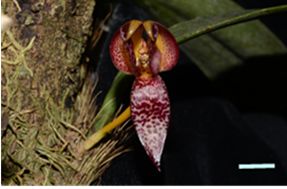Movements of floral parts and roles of the tooth on the column wall of Bulbophyllum praetervisum (Orchidaceae) flower in pollination by Dacini fruit flies (Diptera: Tephritidae)
DOI:
https://doi.org/10.26786/1920-7603(2018)19Abstract
Bulbophyllum is the largest genus of the orchid family, with about 2000 species that are mainly pollinated by flies. Flowers of many Bulbophyllum species under the Sections Sestochilos and Beccariana specifically attract Dacini fruit flies, Bactrocera and Zeugodacus species, as pollinators. Non-nectar producing and non-resupinate solitary flowers of Bu. pratervisum emit specific and pleasant floral fragrances to specifically attract and reward male fruit flies. Slippery surfaces on their lateral sepals aid in pollination. Although pollinia removal by male fruit flies has been observed frequently, deposition of pollinia to complete pollination (by two males of Ba. albistrigata and Z. caudatus) has only been observed recently. Field observations show two previously unreported movements of floral parts – a) petals and medial sepal during daily closing and reopening of flowers, and b) the spring-loaded and hinged lip during removal and deposition of pollinia by a male fruit fly. Additionally, a third (novel) movement has been observed, either when the flower closes for the night to protect the stigma, or after a fly has deposited the pollinia onto the stigma, the 'acute tooth' on each column wall folds inwards specifically to secure the newly deposited pollinia.

Downloads
Published
How to Cite
Issue
Section
License
Copyright (c) 2018 Keng Hong Tan, Lin Tze Tan

This work is licensed under a Creative Commons Attribution 4.0 International License.
JPE is an open access journal which means that all content is freely available without charge to the user or his/her institution.
Authors who publish with this journal agree to the following terms:
1) Authors retain copyright and grant the journal right of first publication with the work simultaneously licensed under a Creative Commons Attribution License that allows others to share the work with an acknowledgement of the work's authorship and initial publication in this journal.
2) Authors are able to enter into separate, additional contractual arrangements for the non-exclusive distribution of the journal's published version of the work (e.g., post it to an institutional repository or publish it in a book), with an acknowledgement of its initial publication in this journal.
3) Authors are permitted and encouraged to post their work online (e.g., in institutional repositories or on their website) prior to and during the submission process, as it can lead to productive exchanges, as well as earlier and greater citation of published work (See The Effect of Open Access).
To assure a broader targeted audience, content will be included into databases (such as EBSCO) and directories (such as DOAJ).











